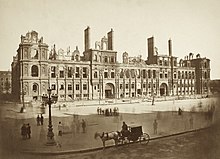Hotel de Ville (Paris)


The Hôtel de Ville [ oˈtɛl də vil ] is the city hall of Paris built in the second half of the 19th century in the neo-Renaissance style . The town hall is located in the 4th arrondissement named after him on the Place de l'Hôtel-de-Ville - Esplanade de la Liberation on Rue de Rivoli .
history

The first building on the site, the Maison des Piliers , dates from the 14th century and was rededicated as the town hall by Étienne Marcel in 1357 . In the 16th century it was demolished due to its dilapidation and rebuilt in the Renaissance style. On September 4, 1870, the Third Republic was proclaimed in the building . During the Paris Commune , the Hotel de Ville was set on fire, destroying the city archives and leaving only the facade.
The current building with 146 statues on the facade was built between 1874 and 1882. It was designed by the architects Théodore Ballu (1817–1885) and Pierre Deperthes (1833–1898).
In the Middle Ages, the square in front of the town hall was the oldest port and landing place and the nucleus of the city of Paris. The most important goods were handled here. Its sandy, flat bank gave it the name Place de Grève (German: Sanduferplatz). Because of the many strikes by dissatisfied workers, the terms “faire (la) grève” and “être en grève” took on the meaning of “strike”. The square was notorious for its public executions over the centuries . The gallows , pillory and execution block stood in the square.
A guillotine was also stationed in the square during the revolution . On July 14, 1789, the day of the storm on the Bastille, Jacques de Flesselles was lynched here by a crowd and his head was severed from his body as a trophy. In the Hôtel de Ville, on 9th Thermidor II (July 27, 1794) Robespierre was shot in the jaw and arrested. The next day he was executed.
On March 19, 1803, the Place de Grève ( German "Strike Place" ) was renamed Place de l'Hôtel-de-Ville (Town Hall Square). It has been reserved for pedestrians since 1982. Since April 22, 2013 it has also been called Esplanade de la Liberation to “honor all those who were in the Resistance , the Forces françaises de l'intérieur , the 4th Infantry on the night of August 24-25, 1944 Division for the liberation of Paris ”.
The members of the Commission du Vieux Paris meet once a month in the hotel .
literature
- Not artist, but municipal councilor . In: The Gazebo . Issue 33, 1867, pp. 528 ( full text [ Wikisource ]).
- Julia Droste-Hennings, Thorsten Droste: Paris. DuMont, Cologne 2003, ISBN 3-7701-6090-8 , pp. 160-161.
- Marius Vachon: Le nouvel Hotel de Ville de Paris. 1872-1900. Conseil Municipal, Paris 1900.
- Heinfried Wischermann: Architecture Guide Paris. Gerd Hatje, Ostfildern 1997, ISBN 3-7757-0606-2 , p. 105.
Web links
- Hotel de Ville (Paris). In: Structurae
- Virtual tour of the town hall
- Hôtel de Ville - A private picture gallery
Individual evidence
- ↑ lexpress.fr of April 22, 2013, "Paris: la place de l'Hôtel-de-Ville devient l'esplanade de la Liberation"
Coordinates: 48 ° 51 ′ 23 " N , 2 ° 21 ′ 8" E
